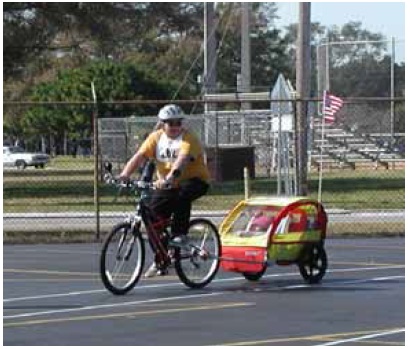Refuge Islands
When designing a path crossing of a roadway, refuge islands are frequently provided between opposing motor vehicle traffic flows to allow pathway users to cross only one direction of traffic at a time. AASHTO (p. 52) currently states that, with respect to this refuge, 2.0 m (6 ft) is "poor," 2.5 m (8 ft) is "satisfactory," and 3.0 m (10 ft) is "good."(29) However, recumbent bicycles, bicycles with trailers, and hand cycles all have 85th percentile lengths greater than 1.8 m (6 ft). The longest likely users, bicycles with trailers, exceeded 2.4 m (8 ft) in length and should be considered the critical users (figure 48).

a. Adult bicyclist and child on trailer
Figure 48. The longest users observed in this study exceeded 2.4 m (8 ft) in length and should be considered the critical users.

b. Adult bicyclist and covered trailer. bicycle.
Figure 48. The longest users observed in this study exceeded 2.4 m (8 ft) in length and should be considered the critical users.
29. American Association of State Highway and Transportation Officials. A Policy on Geometric Design of Highways and Streets. (commonly referred to as “Green Book”) American Association of State Highway and Transportation Officials, Washington, DC, 2001.

User Comments/Questions
Add Comment/Question